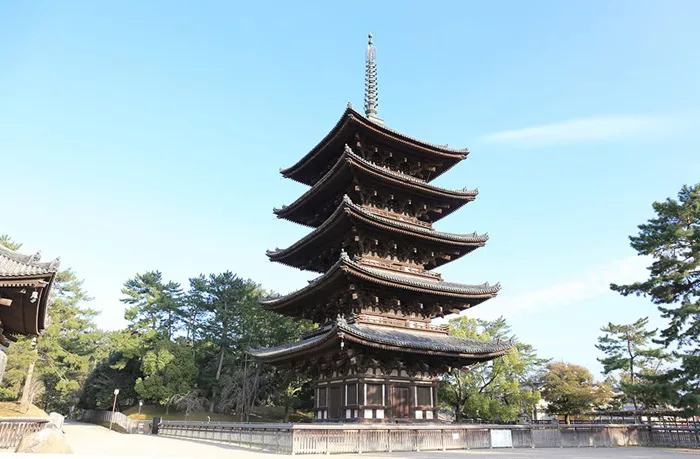The five-story pagoda is a famous type of building found mainly in buddhist temples. It is a unique symbol in temple architecture that holds deep religious and cultural meaning. Many people visit these pagodas to feel peace and learn about Buddhism. This article will explain what a five-story pagoda is, its history, design, and spiritual importance.
The Origin of the Five-story Pagoda
The five-story pagoda began in ancient India, where Buddhism was born. Early Buddhists built structures called stupas to hold sacred relics of the Buddha and other holy objects. When Buddhism spread to China, Korea, and Japan, these stupas evolved into pagodas.
The five-story pagoda is especially common in Japan. It represents the Buddhist universe in a symbolic way. Each level of the pagoda has a special meaning connected to Buddhist teachings. Over time, the pagoda became not just a religious building but also a work of art and a symbol of protection.
Basic Structure of the Five-story Pagoda
A typical five-story pagoda has five distinct levels stacked on top of each other. Each level has a roof that curves upward at the edges, a style typical of buddhist architecture. The structure is tall and slender, designed to reach towards the sky.
The Five Levels and Their Meaning
Each of the five stories represents one of the five elements in Buddhist cosmology:
- Earth (Chi): The bottom floor represents the earth, symbolizing stability and foundation.
- Water (Sui): The second level stands for water, which is fluid and adaptable.
- Fire (Ka): The third floor symbolizes fire, representing energy and transformation.
- Wind (Fu): The fourth story represents wind, symbolizing movement and freedom.
- Void or Sky (Ku): The top level stands for the void or sky, the ultimate spiritual realm.
Together, these five elements show the Buddhist idea of the world and the path to enlightenment.
Architectural Features of the Five-story Pagoda
The design of a five-story pagoda is both beautiful and functional. Builders used wooden materials and special joints to make the structure flexible. This design helps the pagoda survive earthquakes, which are common in countries like Japan.
The Central Pillar (Shinbashira)
One of the most important parts of the pagoda is the central pillar, called shinbashira in Japanese. This pillar runs from the base to the top of the pagoda. It acts like a spine, keeping the building stable during strong winds and earthquakes.
Roof Design
Each story has its own roof with wide eaves that curve upwards. This style is common in many East Asian temples. The curved roof helps protect the building from rain and snow. The edges of the roofs often have small bells that ring in the wind, adding a peaceful sound to the temple grounds.
Spiritual and Cultural Significance
The five-story pagoda is not just a building. It is a symbol of Buddhist teachings and a place for meditation. Many Buddhists believe that being near a pagoda can bring spiritual protection and good luck.
Relics and Sacred Objects
Pagodas often contain relics of the Buddha or important monks. These sacred objects make the pagoda a holy place. Pilgrims come from far away to pray and pay respect. The structure itself represents the Buddha’s presence on earth.
Symbol of the Buddhist Universe
The five stories reflect the Buddhist understanding of the universe. They remind followers of the path from the physical world (earth) to spiritual awakening (void). The pagoda inspires people to think about their own journey to enlightenment.
Famous Five-story Pagodas Around the World
Many famous five-story pagodas can be found in Asia. Here are some well-known examples:
To-ji Pagoda, Japan
The To-ji Pagoda in Kyoto is one of the tallest wooden pagodas in Japan. It stands about 54 meters high and was built in the 9th century. It is an important cultural treasure and attracts many visitors every year.
Horyu-ji Pagoda, Japan
Horyu-ji Temple houses one of the oldest wooden pagodas in the world, built in the 7th century. It represents early Japanese Buddhist architecture and has influenced many other temple designs.
Other Notable Pagodas
Besides Japan, five-story pagodas are found in China and Korea, each with unique features but similar symbolic meaning. These pagodas are often part of larger temple complexes and remain important places for Buddhist worship and cultural heritage.
How the Five-story Pagoda is Used Today
Today, many pagodas serve as tourist attractions and places for religious practice. Monks perform ceremonies there, and visitors can learn about Buddhist history and architecture. The pagoda stands as a bridge between ancient traditions and modern life.
Preservation and Restoration
Because pagodas are made of wood and are old, many require careful maintenance. Specialists use traditional methods to restore damaged parts, keeping the original design intact. This work helps protect these sacred buildings for future generations.
Conclusion
The five-story pagoda is a beautiful and meaningful symbol in Buddhism. It combines art, architecture, and spiritual teachings into one unique structure. Whether you visit a pagoda to admire its design or to seek peace, understanding its background adds to the experience.

